Gender Dissimilarities in Human Capital Transferability of Cuban Immigrants in the US: A Clustering Quantile Regression Coefficients Approach with Consideration of Implications for Sustainability
Abstract
:1. Introduction
2. Materials and Methods
2.1. Linear Quantile Regression
2.2. Quantile Regression Coefficients Modeling (QRCM)
2.3. Cluster of Effects Curves (CEC)
2.4. Descriptive Characteristics of the Sample
3. Empirical Results
- For Women
- (i)
- Cluster 1 contained the effect of the variables, indicating that the individual is a US citizen and proficient in English. This cluster had the greatest positive impact on earnings. This effect increased toward the higher locations of the earnings’ distribution.
- (ii)
- Cluster 2 contained the effect of the curve associated with age at the time of migration. This cluster had an almost constant and negative effect throughout the conditional earnings’ distribution.
- (iii)
- Cluster 3 contained the effects of variables associated with years of education and potential work experience, as well as the effect of the variable indicating that the individual is married. The cluster effect was positive and almost constant but close to zero. The positive impact was more important for individuals at the upper tail of the earnings’ distribution.
- For Men
- (i)
- Cluster 1 contained the effects of the variables indicating that an individual is a US citizen and proficient in English, as for women. This cluster had the greatest positive impact on earnings. This effect increased toward the higher locations of the earnings’ distribution. However, unlike what was observed for women, the trend change of the curve for the upper tail of the distribution was smoother.
- (ii)
- Cluster 2 contained the effects of the curve associated with age at the time of migration and marriage status. The cluster effect was constant, close to zero, and basically conditioned by the negative impact of age at time of migration on earnings.
- (iii)
- Cluster 3 involved the functions related to the covariates associated with years of education and potential work experience. The observed cluster effect was positive but almost constant and close to zero. The positive impact was more important for individuals at the bottom of the earnings’ distribution.
4. Conclusions
Author Contributions
Funding
Institutional Review Board Statement
Informed Consent Statement
Data Availability Statement
Conflicts of Interest
References
- Blau, F.D.A.K.; Lawrence, M. Gender Wage Gap: Extent, Trends, and Explanations. J. Econ. Lit. 2017, 55, 789–865. [Google Scholar] [CrossRef] [Green Version]
- Becker, G.S. Human Capital: A Theoretical and Empirical Analysis, with Special Reference to Education, 2nd ed.; University of Chicago Press: Chicago, IL, USA, 1980; pp. xviii, 268 and Ill. [Google Scholar]
- Bergmann, B.R. Occupational Segregation by Sex: The Root of Women’s Disadvantage. In Economic Emergence of Women, 2nd ed.; Palgrave Macmillan: New York, NY, USA, 2005; pp. 61–84. [Google Scholar]
- Addison, J.T.; Ozturk, O.D.; Wang, S. The Occupational Feminization of Wages. ILR Rev. 2018, 71, 208–241. [Google Scholar] [CrossRef] [Green Version]
- Magnusson, C. Mind the Gap: Essays on Explanations of Gender Wage Inequality. Ph.D. Thesis, Institute of Social Research, Stockholm University, Stockholm, Sweden, 2010. [Google Scholar]
- England, P. Comparable Worth Theories and Evidence; Routledge: London, UK, 2017. [Google Scholar]
- Reid, L.L. Devaluing women and minorities—The effects of race/ethnic and sex composition of occupations on wage levels. Work Occup. 1998, 25, 511–536. [Google Scholar] [CrossRef]
- Cohen, P.N.; Huffman, M.R.L. Individuals, jobs, and labor markets: The devaluation of women’s work. Am. Sociol. Rev. 2003, 68, 443–463. [Google Scholar] [CrossRef]
- Smith-Doerr, L.; Alegria, S.; Fealing, K.H.; Fitzpatrick, D.; Tomaskovic-Devey, D. Gender Pay Gaps in US Federal Science Agencies: An Organizational Approach. Am. J. Sociol. 2019, 125, 534–576. [Google Scholar] [CrossRef]
- Weeden, K.A. Why do some occupations pay more than others? Social closure and earnings inequality in the United States. Am. J. Sociol. 2002, 108, 55–101. [Google Scholar] [CrossRef]
- Kalleberg, A.L. Precarious Work, Insecure Workers: Employment Relations in Transition. Am. Sociol. Rev. 2009, 74, 1–22. [Google Scholar] [CrossRef] [Green Version]
- DiPrete, T.A.; Eller, C.C.; Bol, T.; van de Werfhorst, H.G. School-to-Work Linkages in the United States, Germany, and France. Am. J. Sociol. 2017, 122, 1869–1938. [Google Scholar] [CrossRef] [Green Version]
- Gradin, C. Segregation of Women into Low-paying Occupations in the United States. Appl. Econ. 2020, 52, 1905–1920. [Google Scholar] [CrossRef]
- US Census Bureau. Geographical Mobility and Migration Main; U.S. Department of Commerce: Washington, DC, USA, 2019. [Google Scholar]
- Massey, D.S. Immigration Policy Mismatches and Counterproductive Outcomes: Unauthorized Migration to the US in two eras. Comp. Migr. Stud. 2020, 8, 21. [Google Scholar] [CrossRef]
- Cobas-Valdés, A.; Sainz, A.F. Cuban Migration to the United States and the Educational Self Selection Problem. Int. J. Cuba. Stud. 2014, 6, 41–54. [Google Scholar] [CrossRef]
- Basiago, A.D. Sustainable development in Indonesia—A case-study of an indigenous regime of environmental-law and policy. Int. J. Sustain. Dev. World Ecol. 1995, 2, 199–211. [Google Scholar] [CrossRef]
- Mensah, J. Sustainable development: Meaning, history, principles, pillars, and implications for human action: Literature review. Cogent Soc. Sci. 2019, 5, 1653531. [Google Scholar] [CrossRef]
- Sawicka, J.; Lagoda, J. Gender and Sustainability in the Economic Development: Equal Chances for Women at the Labor Market. Oeconomia 2015, 14, 115–125. [Google Scholar]
- Martins, P.S.; Pereira, P.T. Does education reduce wage inequality? Quantile regression evidence from 16 countries. Labour Econ. 2004, 11, 355–371. [Google Scholar] [CrossRef]
- Kneib, T. Beyond Mean Regression. Stat. Model. 2013, 13, 275–303. [Google Scholar] [CrossRef] [Green Version]
- Haupt, H.; Lösel, F.; Stemmler, M. Quantile Regression Analysis and Other Alternatives to Ordinary Least Squares: A Methodological Comparison on Corporal Punishment. Methodol. Eur. J. Res. Methods Behav. Soc. Sci. 2014, 10, 81–91. [Google Scholar] [CrossRef]
- Sottile, G.; Adelfio, G. Clusters of effects curves in quantile regression models. Comput. Stat. 2019, 34, 551–569. [Google Scholar] [CrossRef]
- Frumento, P.; Bottai, M. Parametric Modeling of Quantile Regression Coefficient Functions. Biometrics 2016, 72, 74–84. [Google Scholar] [CrossRef]
- Koenker, R.; Bassett, G. Regression Quantiles. Econometrica 1978, 46, 33–50. [Google Scholar] [CrossRef]
- Ruggles, S.; King, M.L.; Levison, D.; McCaa, R.; Sobek, M. Machine-Readable Database, Version 5.0; In Integrated Public Use Microdata Series (IPUMS); IPUMS: Minneapolis, MN, USA, 2019. [Google Scholar]
- Davino, C.; Vistocco, D. Quantile Regression for Clustering and Modeling Data. Advances in Statistical Models for Data Analysis; Springer: Cham, Switzerland, 2015; pp. 85–95. [Google Scholar] [CrossRef]
- Geraci, M. Modelling and estimation of nonlinear quantile regression with clustered data. Comput. Stat. Data Anal. 2019, 136, 30–46. [Google Scholar] [CrossRef] [PubMed] [Green Version]
- Sottile, G.; Francipane, A.; Adelfio, G.; Noto, L.V. A PCA-based clustering algorithm for the identification of stratiform and convective precipitation at the event scale: An application to the sub-hourly precipitation of Sicily, Italy. Stoch. Environ. Res. Risk Assess. 2021, 1–15. [Google Scholar] [CrossRef]
- Bertoli, S.; Fernandez-Huertas Moraga, J.; Ortega, F. Crossing the border: Self-selection, earnings and individual migration decisions. J. Dev. Econ. 2013, 101, 75–91. [Google Scholar] [CrossRef] [Green Version]
- Technical Report; US Bureau of Labor Statistics, Wage and Hour Division: Washington, DC, USA, 2020.
- Friedberg, R.M. The Labor Market Assimilation of Immigrants in the United States: The Role of Age at Arrival; Working Papers; Brown University: Providence, RI, USA, 1992. [Google Scholar]
- Fitzsimons, P. Human Capital Theory and Education. In Encyclopedia of Educational Philosophy and Theory; Springer: Cham, Switzerland, 2015; pp. 1–5. [Google Scholar]
- Ponthieux, S.; Meurs, D. Gender Inequality. Handb. Income Distrib. 2015, 2, 981–1146. [Google Scholar]
- Ransom, M.R.; Oaxaca, R.L. New Market Power Models and Sex Differences in Pay. J. Labor Econ. 2010, 28, 267–289. [Google Scholar] [CrossRef] [Green Version]
- Choi, S.H.; Jang, H. How Can Marriage Immigrants Contribute to the Sustainability of the Host Country? Implications from the Leisure and Travel Patterns of Vietnamese Women in South Korea. Sustainability 2021, 13, 1039. [Google Scholar] [CrossRef]
- Del Valle, I.D.; Castillo, M.A. Human capital and sustainable competitive advantage: An analysis of the relationship between training and performance. Int. Entrep. Manag. J. 2009, 5, 139–163. [Google Scholar] [CrossRef]
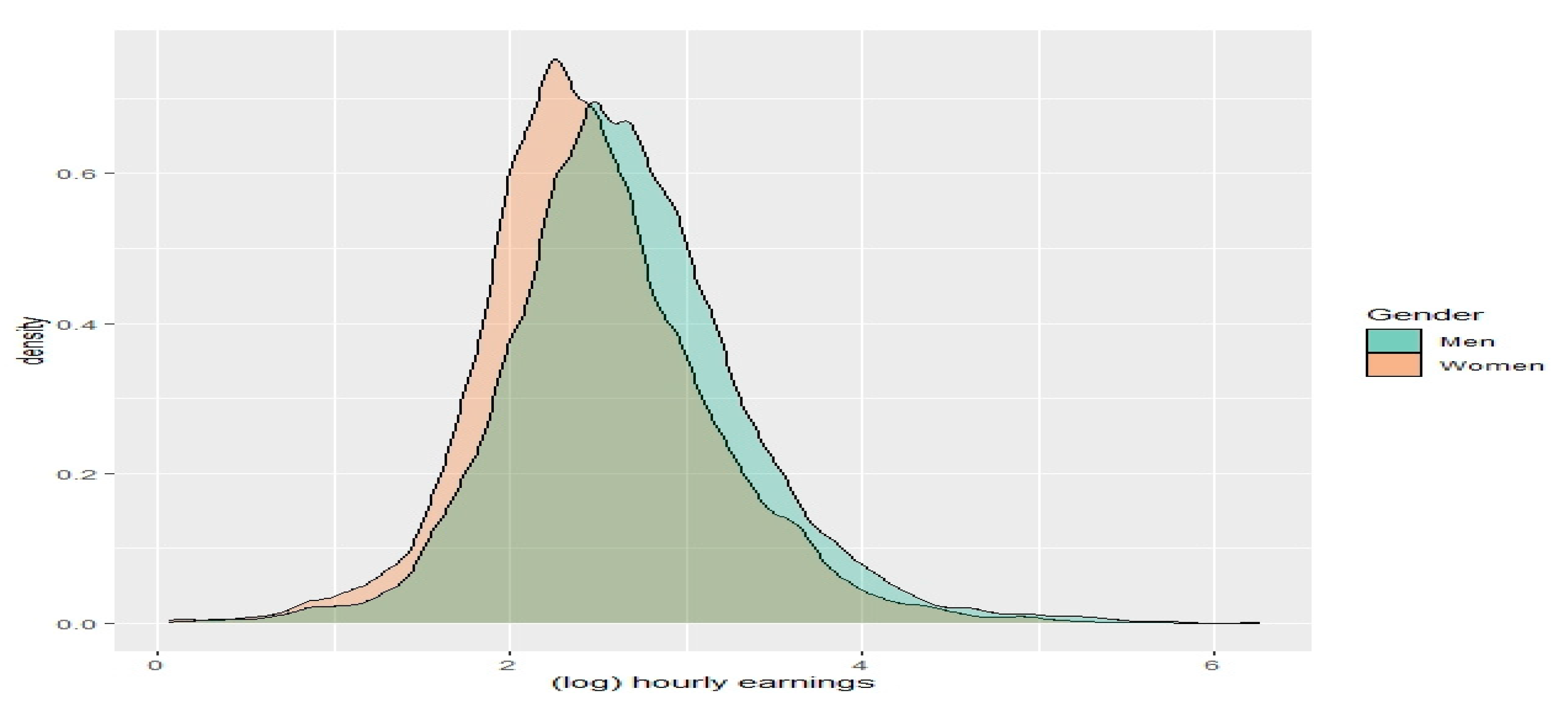
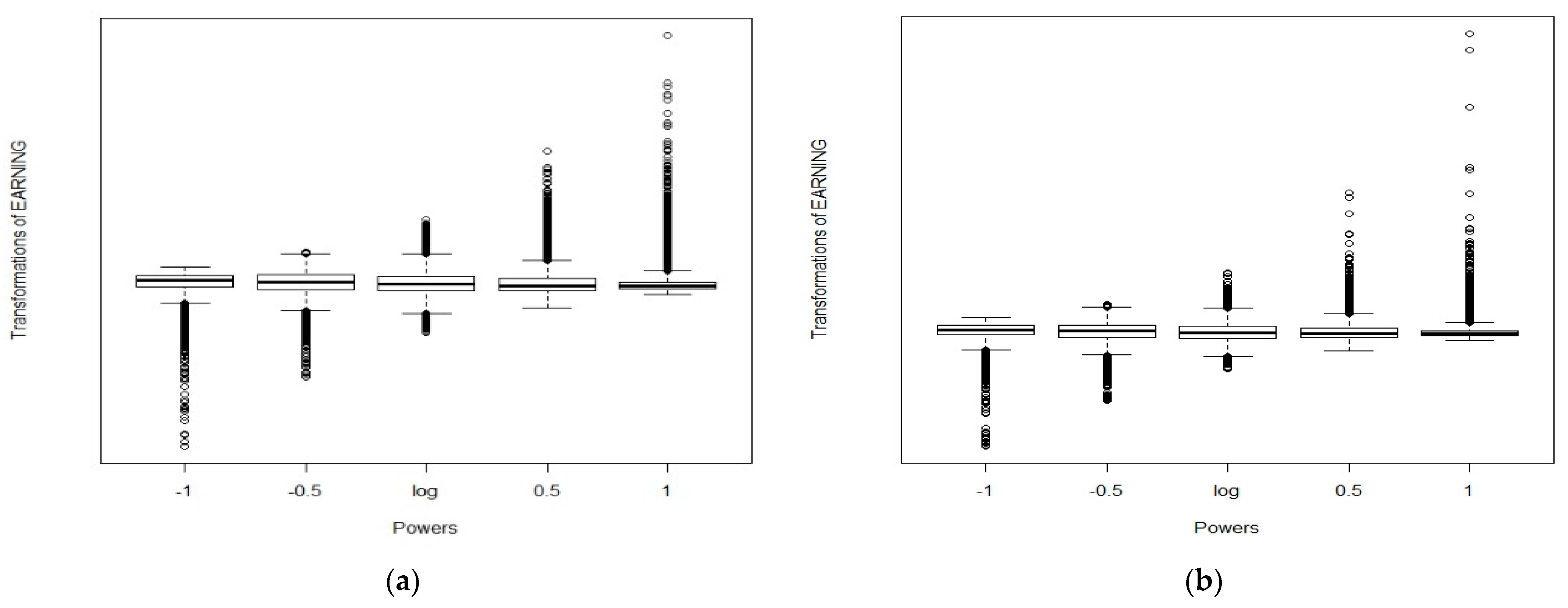
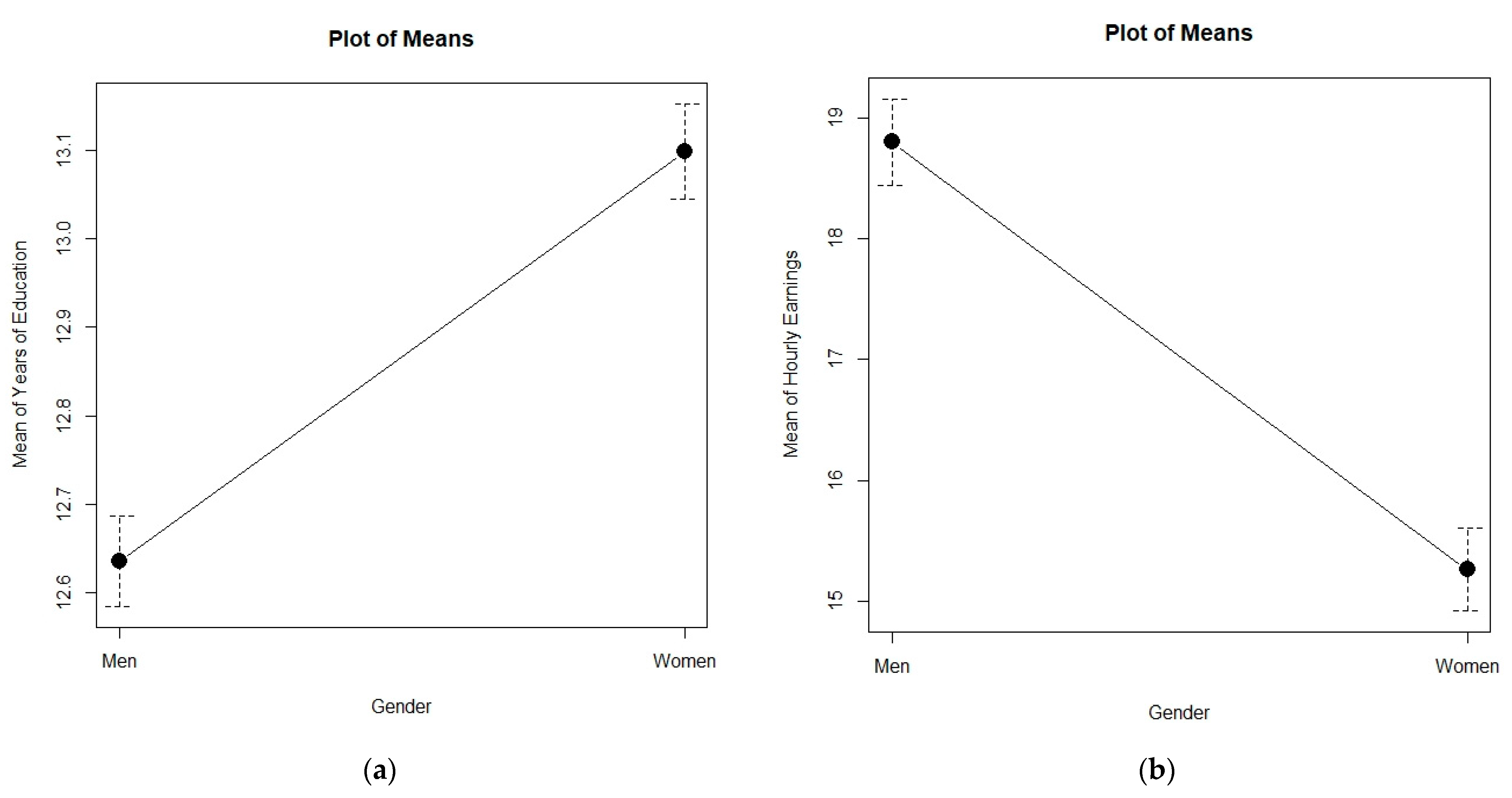
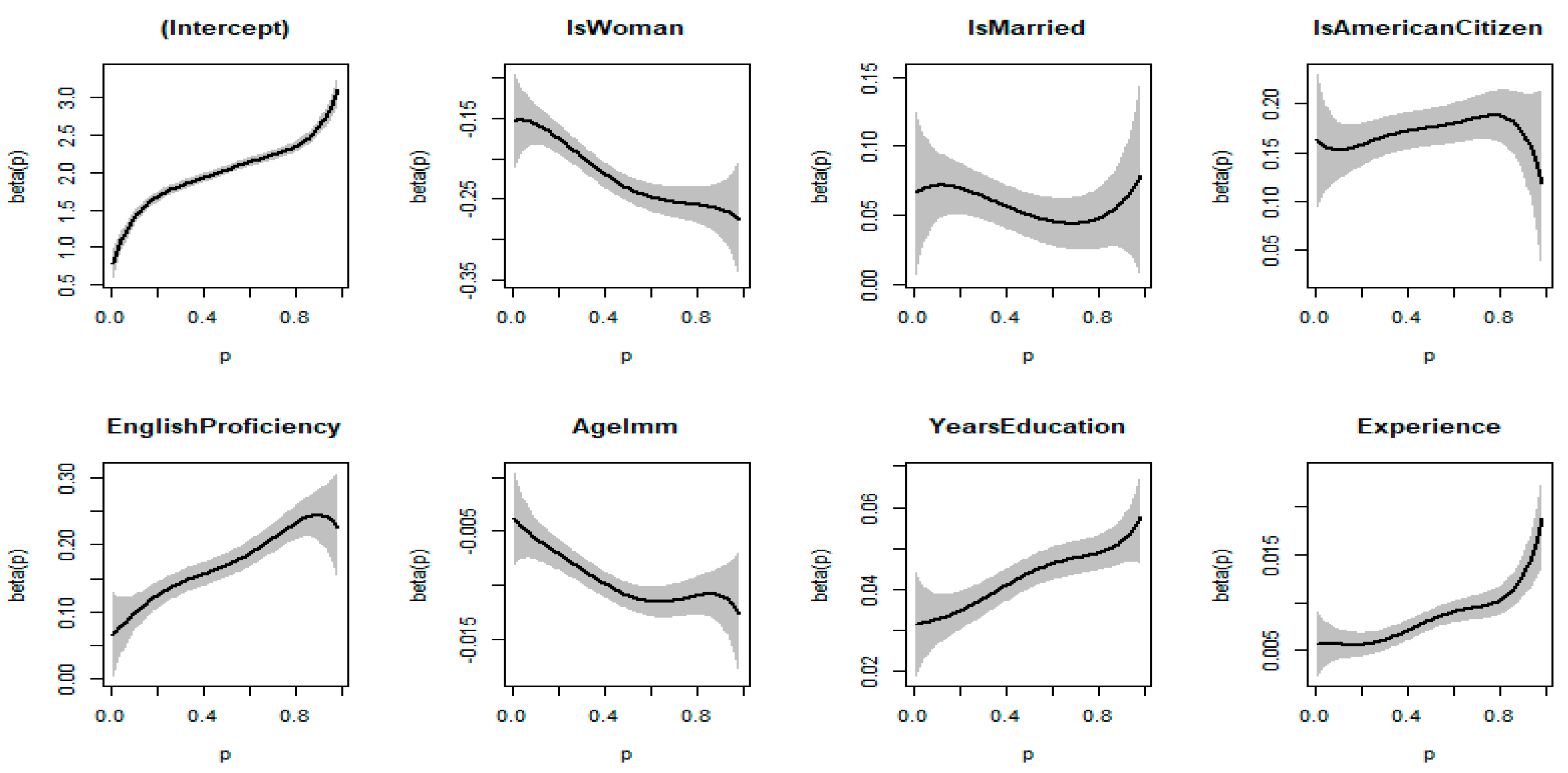
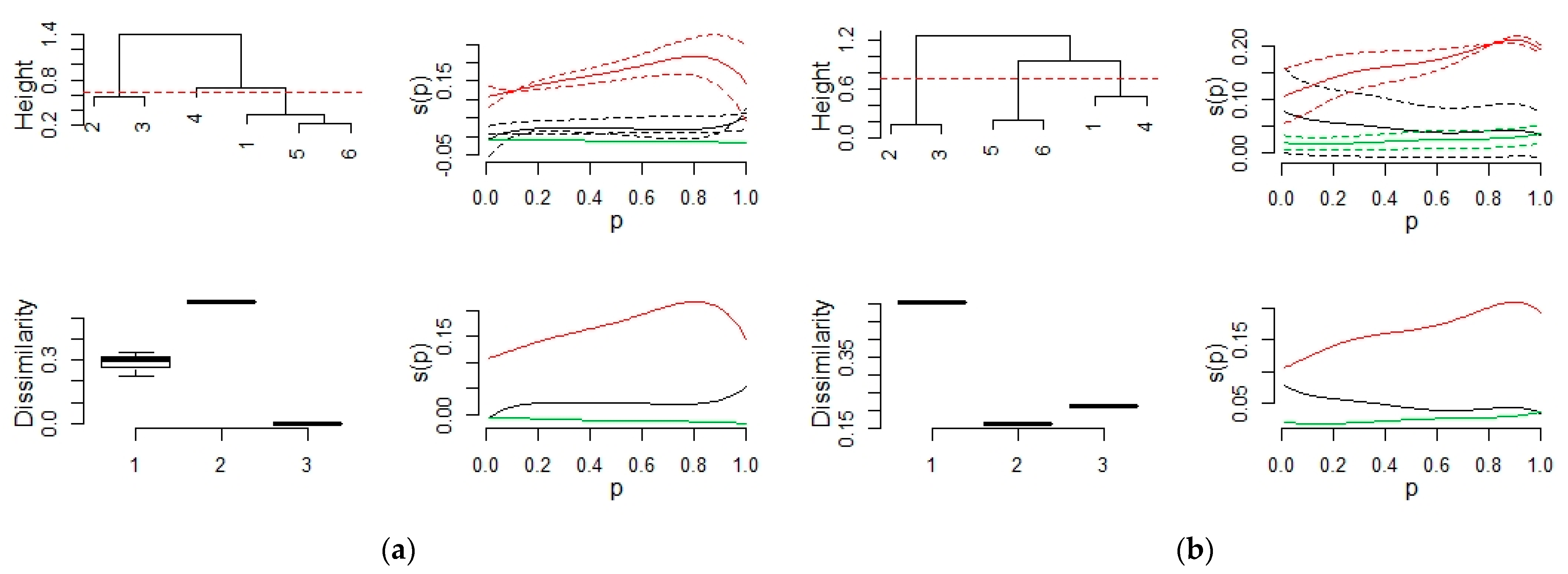
| Variables | Mean | 1st Quartile | Median | 3rd Quartile | ||||
|---|---|---|---|---|---|---|---|---|
| Women | Men | Women | Men | Women | Men | Women | Men | |
| Hourly Earnings | 15.26 | 18.79 | 7.74 | 9.62 | 11.15 | 13.94 | 16.83 | 21.15 |
| Years of Education | 13.10 | 12.64 | 12.00 | 12.00 | 12.00 | 12.00 | 16.00 | 14.00 |
| Potential Experience | 25.76 | 26.60 | 18.00 | 20.00 | 26.00 | 27.00 | 33.00 | 33.50 |
| Age at Migration | 31.04 | 31.30 | 24.00 | 25.00 | 30.00 | 31.00 | 38.00 | 37.00 |
| Working Hours per Week | 36.78 | 40.03 | 35.00 | 40.00 | 36.78 | 40.00 | 40.00 | 40.00 |
| Weeks Worked per Year | 47.33 | 47.81 | 52.00 | 52.00 | 52.00 | 52.00 | 52.00 | 52.00 |
| Is an American Citizen | 0.49 | 0.42 | ||||||
| Has Proficiency in English | 0.52 | 0.51 | ||||||
| Is Married | 0.54 | 0.58 | ||||||
| In Labor Force | 0.97 | 0.97 | ||||||
| Gender | 0.44 | 0.56 | ||||||
| Dependent Variable: (log) Hourly Earnings | ||||||
|---|---|---|---|---|---|---|
| Intercept | ||||||
| Intercept | 0.6817 (0.1164) | 0.7888 ** (0.0407) | –0.0549 ** (0.0415) | 0.3338 ** (0.0408) | –0.0088 ** (0.0316) | 0.1354 ** (0.0294) |
| Is Woman | –0.1537 ** (0.0338) | –0.0662 ** (0.0126) | 0.0194 ** (0.0131) | 0.0044 ** (0.0130) | –0.01283 *** (0.0099) | 0.0003 *** (0.0091) |
| Is Married | 0.0649 ** (0.0340) | –0.0087 ** (0.0127) | 0.01553 ** (0.0131) | 0.0154 ** (0.0131) | –0.0001 *** (0.0099) | 0.0015 *** (0.0092) |
| Is an American Citizen | 0.1655 ** (0.0394) | 0.0075 ** (0.0154) | –0.0213 ** (0.0160) | –0.0229 ** (0.0163) | –0.0109 ** (0.0123) | 0.0015 ** (0.0117) |
| Proficiency in English | 0.0619 ** (0.0372) | 0.0884 ** (0.0141) | –0.0104 ** (0.0146) | –0.0004 ** (0.0145) | –0.0189 ** (0.0110) | –0.0083 ** (0.0104) |
| Age at Migration | –0.0035 *** (0.0025) | –0.0037 *** (0.0009) | 0.0022 *** (0.0010) | –0.0004 *** (0.0010) | –0.0009 *** (0.0008) | –0.0007 *** (0.0007) |
| Years of Education | 0.0314 *** (0.0074) | 0.0122 *** (0.0024) | –0.0004 *** (0.0025) | 0.0004 *** (0.0023) | 0.0025 *** (0.0018) | 0.0009 *** (0.0017) |
| Potential Experience | 0.0056 *** (0.0019) | 0.0048 *** (0.0008) | 0.0022 *** (0.0008) | 0.0012 *** (0.0008) | 0.0019 *** (0.0006) | 0.0011 *** (0.0006) |
Publisher’s Note: MDPI stays neutral with regard to jurisdictional claims in published maps and institutional affiliations. |
© 2021 by the authors. Licensee MDPI, Basel, Switzerland. This article is an open access article distributed under the terms and conditions of the Creative Commons Attribution (CC BY) license (https://creativecommons.org/licenses/by/4.0/).
Share and Cite
Cobas-Valdés, A.; Fernández-Macho, J. Gender Dissimilarities in Human Capital Transferability of Cuban Immigrants in the US: A Clustering Quantile Regression Coefficients Approach with Consideration of Implications for Sustainability. Sustainability 2021, 13, 12004. https://doi.org/10.3390/su132112004
Cobas-Valdés A, Fernández-Macho J. Gender Dissimilarities in Human Capital Transferability of Cuban Immigrants in the US: A Clustering Quantile Regression Coefficients Approach with Consideration of Implications for Sustainability. Sustainability. 2021; 13(21):12004. https://doi.org/10.3390/su132112004
Chicago/Turabian StyleCobas-Valdés, Aleida, and Javier Fernández-Macho. 2021. "Gender Dissimilarities in Human Capital Transferability of Cuban Immigrants in the US: A Clustering Quantile Regression Coefficients Approach with Consideration of Implications for Sustainability" Sustainability 13, no. 21: 12004. https://doi.org/10.3390/su132112004
APA StyleCobas-Valdés, A., & Fernández-Macho, J. (2021). Gender Dissimilarities in Human Capital Transferability of Cuban Immigrants in the US: A Clustering Quantile Regression Coefficients Approach with Consideration of Implications for Sustainability. Sustainability, 13(21), 12004. https://doi.org/10.3390/su132112004







